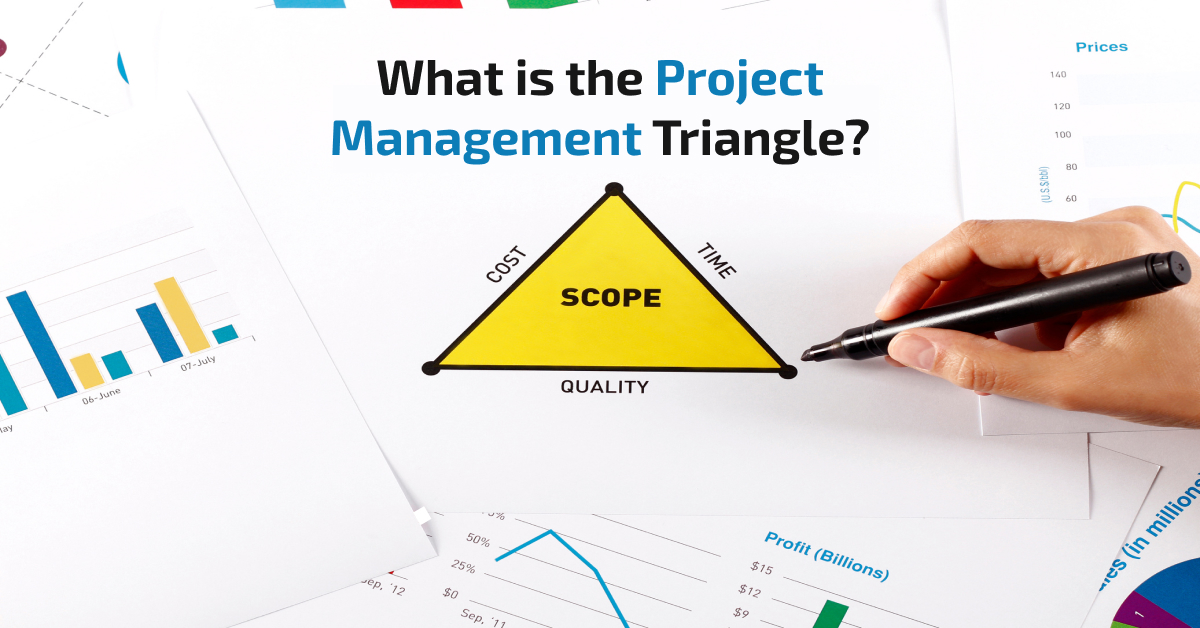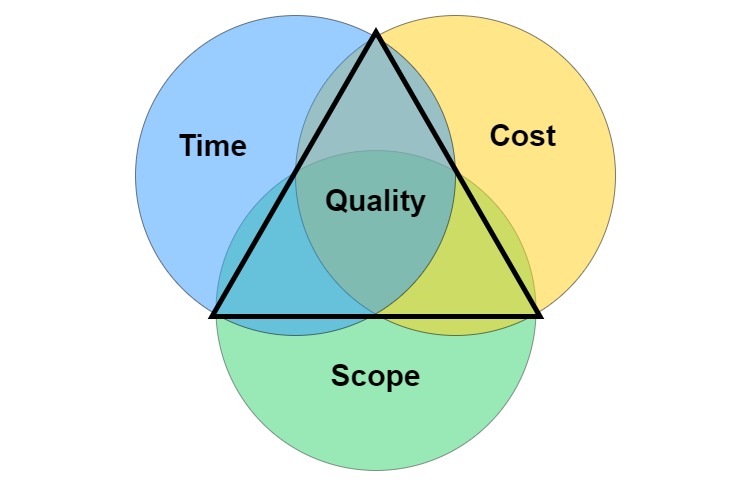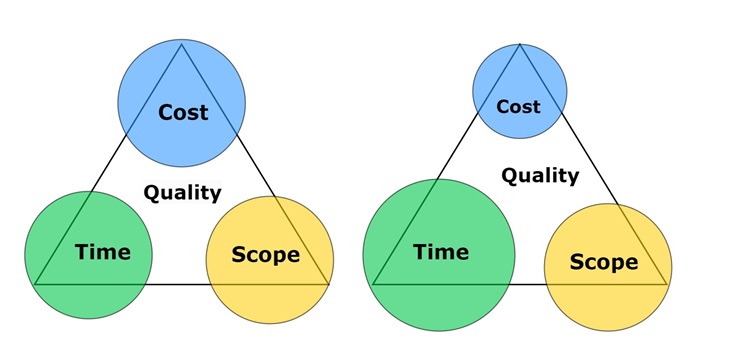Blog Technology industry trends
What is the Project Management Triangle? Definition, Examples, and Importance

Maintaining high-quality standards during the project life cycle is essential for project managers. As a project manager you have to achieve these quality standards using various strategies and tools. The project management triangle is one of the strategies you must learn as a project manager to set up the project scope and define the complete roadmap. It ensures quality without compromising cost, time, and tasks. But what is a project management triangle, and why is it important? This blog is about the project management triangle and the breakdown of triple constraints. We will also explain the challenges and the tools you can use for the project management triangle.
What is the Project Management Triangle?
The project management triangle is the three-constraint model that balances the overall project lifecycle. This triangle, also called a triple constraint, sets the connection between time, cost, and scope to maintain quality.

It is one of the most initial tasks in planning and documenting the project's scope statement. The balance between time, cost, and scope is required to control the quality. That's why adjusting the other two becomes essential if project managers modify one constraint. Moreover, this concept is also known as the iron triangle and flexibility matrix.
Constraints in the Iron Triangle
The triple constraints are the scope, cost, and time used to ensure optimal quality. Here is the breakdown of these constraints:
1. The Scope Constraint
The project scope includes the project cycle's objectives, team, timeline, deadlines, and required tasks. A project manager must control and manage the scope to ensure everything goes along the track to reach the predicted results.
2. The Time Constraint
The time constraint includes the overall timeline of a project and deadlines to reach objectives. With scope, you will have to control the project timeline, set schedules for your goals, and ensure deadlines for the team. As the project manager, you can use various time management techniques to adjust the tasks for better results.
3. The Cost Constraint
Resource planning for the project's entire lifecycle is important, given the cost of the overall budget. Cost management facilitates maintaining paid resources such as equipment, tools, materials, and the team required for the project. That's why micro-adjustments to the budgets can affect the time and scope of the project management.
Importance of Project Management Triangle
Why should you focus on the project management triangle as a project manager? The answer is simple: it can standardize the project management process and make it smoother. The iron triangle can improve various functions, such as:
1. Meeting the Expectations
With the correct management and high-quality triple constraints, you can meet the client's expectations within the limited budget and time. You can also modify these constraints during the project development to stay on the expected objectives.
2. Reducing the Risk
With the project scope and time management, you can evaluate the potential risks and implement strategies to eliminate them without issues. You can reduce risks like uncontrolled processes, over-budget issues, and unexpected delays.
3. Strong Decision Making
The iron triangle can empower your decision-making as it works as a standard framework for project development. With the correct objective and set goals, you can also make important decisions without delaying the project life cycle.
4. Eliminate Scope Creep
Project scope management eliminates the chances of scope creep and unmanaged modifications. With greater flexibility, you can make notable changes quickly without hampering quality.
How to Manage the Triple Constraints?
Managing the triple constraints is one of the essential tasks during project management. Hence, as a project manager, there are a few strategies that you can use to maintain the quality and high standards during the project life cycle.
1. Set Priorities for the Project
Communicate with the clients, stakeholders, and team to set the project's priorities and goals. Make sure you balance these three constraints while setting the priorities. However, make sure you set the priorities at the beginning of the project lifecycle, or else a sudden modification may definitely lead to quality issues. As a project manager, you set regular meetings with clients and update them about the schedules, deadlines, budgets, and required modifications for the project life cycle.
2. Follow the Standard Strategies
To balance all three constraints, you need to follow the standard strategies. These strategies require regular planning and modifications if needed. As a project manager, you can use the following strategies.
-
Critical Path Method (CPM) for Time Management: The critical path method is used to identify all tasks that can directly impact the overall timeline and project deadlines. This strategy allows you to prioritize those tasks to avoid conflicts between deadlines and expectations.
-
Work Breakdown Structure (WBS) for Project Scope: The WBS strategy must break the entire process into small chunks to make management easier. This strategy allows you to develop a precise project score and correctly divide responsibilities.
-
Earned Value Management (EVM) for Budget Management: Earned value management is used to compare the planning with the actual progress. With the EVM strategy, you can detect the difference between budget expectations and actual expenditures during project management.
-
The Change Control Process for Overall Management: The change control process allows you to manage changes in the project scope and check their impacts on all three constraints.
3. Select a Flexible Constraint
For smoother project management, you must select a specific constraint that you will use as the flexible one. You can find the flexible constraint while creating the Project Scope that can be used as the pinpoint to create room for modifications. For example, if the project has budget issues, then you need to extend the timelines and the deadlines to avoid the usage of financial resources:

4. Risk Management Plan
Reducing the risk for the three constraints is essential to staying aligned with the budget limitations and the given deadlines. Prepare the risk management strategy and address all the potential issues that can impact the overall project life cycle. Moreover, address all the potential risks to the team members, stakeholders, and clients so that you can manage the project in case an error occurs.
Tools to Manage the Project Management Triangle
If you are new to the project management field, don't worry. There are different tools you can use to manage the iron triangle.
1. Roadmunk
You can use Roadmunk to create, manage, and share strategies with your team members and stakeholders. It helps your team members align on a common goal and project objectives. The tool also supports visual representations to make everything easy to understand.
2. ClickUp
ClickUp has a variety of goal-setting frameworks that help project managers track the progress and meet the expected targets. Moreover, you can also use ClickUp to set revenue targets and budget limits to control the resources easily.
3. Monday.com
Monday.com is one of the best tools for high-quality project and task management. This tool has a variety of options for generating workflows and visualizations that help teams organize tasks easily.
4. Teamwork
You can use the Teamwork tool to manage the overall project, team, stakeholders, and clients in one place without juggling multiple tasks. It can help you deliver the project within the expected time and budget.
5. Additional Tools
You can also use standard templates to create visual representations for project timelines, progress, budget limits, and scope. Furthermore, you can also use these templates to prepare Gantt charts to plan and track projects.
Wrapping Up
This was all about the project management triangle and its importance in managing a project's overall life cycle. Please don't get confused about the Project Management triangle, which has multiple names, such as the iron triangle, triple constraints, and flexibility matrix. As a skilled project manager, you must ensure a flexible constraint in the iron triangle, or it can create issues while managing the project life cycle.
Frequently Asked Questions (FAQs)
Q.1 What are the 3s of project management?
Ans. In project management, the 3s are budget, time and scope that makes the iron triangle concept.
Q.2 What is the iron triangle principle?
Ans. The iron triangle works on the principle where modifying one constraint out three can impact the other twos and the quality of the project.
Q.3 Who introduced the iron triangle?
Ans. The Iron triangle was first introduced by Dr. Martin Barnes in 1969 for product development but later it became popular in every sector.
Q.4 What are the benefits of the iron triangle?
Ans. The iron triangle in project management allows you to break down the entire process into small chunks based on the three constraints: scope, time, and budget. This can help you maintain the project's quality without compromising other factors.



